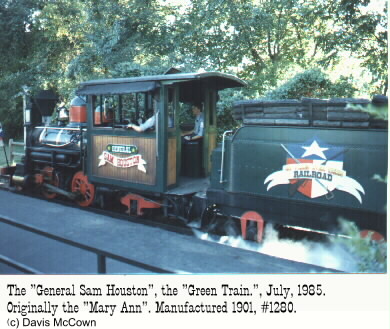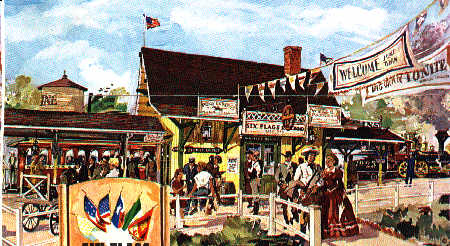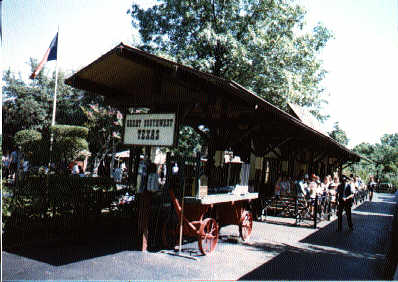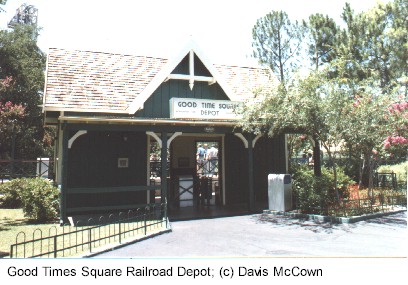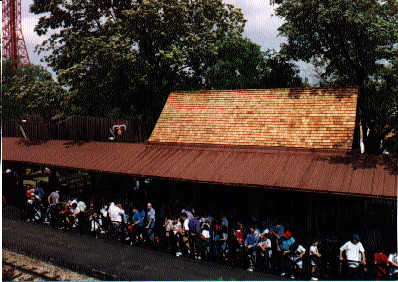Last Year Operated: Currently Operating
Section: Texas
Manufacturer:
Other Names and Nicknames:
The Six Flags Over Texas Railroad
See also the complete SFOT RailRoad Spiel – 1974
See also the complete SFOT RailRoad Spiel – 1961
The Six Flags Railroad is the oldest operating attraction at Six Flags Over Texas and has the distinction of being the ONLY attraction remaining from the park’s initial season.
The trains make a one mile run around the park. The ride is enhanced by the “Spiel of the Conductor“, which points out the sights for the riders, highlights interesting facts about the park, and provides some “corny” entertainment. The spiel changes over the years as new attractions are added and others are removed.

The Engines
The center pieces of the Railroad are the two engines, each of which has an extensive history of its own. Engine Number 1 is known as the Green Train due to its green paint scheme. The Green Train was constructed in 1901 as Engine 1280 of the Dickson Works of the American Locomotive company.
Engine Number 2 is known as the Red Train for its red color scheme. It is the older and smaller of the two engines. It was manufactured in 1897 as Engine Number 1754 of the Porter Company.
Enterprise Plantation
Both Engines were originally built for the Enterprise Plantation, a Sugar Cane Plantation, in Patoutville, Iberia Parish, Louisiana, owned by the Patout family. The Red Train was Enterprise’s first engine and tender and was named the “Lydia”. The Green Train was Enterprise’s second engine and tender and was named the “Mary Ann”.
The Engines were part of a fleet of 8 engines and 220 4 ton cars eventually owned by the plantation railroad, which operated until 1945.
The Engines are Narrow Gauge (36″), meaning that the distance between the two tracks is thirty-six inches. This is smaller than Standard Gauge Railroads, but allows for better maneuverability on tight tracks.
Both engines were leased to Six Flags Over Texas by the Patout Family when the park opened in 1961. As of 1995, the Trains still operated in the park under a lease agreement.

Six Flags Rebuilds the Engines
The Green Train, originally the “Mary Ann” at the Enterprise Plantation, was renamed the “General Sam Houston” by Six Flags, in honor of the Texas hero. Its pulls four cars, and is the primary train of the railroad, operating even on slow days when only one of the two trains is running.
The Red Train, originally the “Lydia” at the Enterprise Plantation, was renamed the “Maribeu B. Lamar”, also in honor of the a Texas hero. It pulls a compliment of three passenger cars. It usually runs as an extra train on crowded days.
The two engines were rebuilt by the park at an estimated cost of $50,000 each. Photographs of the original “Lydia” and the “Mary Ann” hang in the lobby of the Texas Station. Due to reconstruction of the engines, they look different from their current appearance and may not instantly be recognized. A lantern and cattle guard was added the front end of the each train. The Engines are no longer wood burning and the tenders were converted accordingly. Additional guide wheels were added to the front of each engine under the cattle guards.
The front smoke stack on the Green Train was modified. On the Red Train, the covering for the Engineer and Fireman was moved back on the engine and additional windows were added.
The passenger cars were also built for the park.
The Red Train has since been renamed to the Charles Jefferson Patton, in honor of the engineer that operated the Six Flag engines for many years. The Green Train has been renamed in honor of Larry Cochran.

The Engine House
The home to the Trains is an engine house built in the Southwest Corner of the park, outside of the Spanish and Mexican Sections. The Engine House can be viewed by Guests as they ride the trains.
Train Operations – Sights
The Trains originally operated only out of the Six Flags Railroad Station in the Texas Section. The station was officially named the “Great Southwest Station.” Trains left the Texas Station heading North towards the Chaparral cars. They made a non-stop round trip run around the park, which was completely enclosed by the track. Along the way, riders could see some of the parks rides and attractions. Some of the route, however, was through as of yet undeveloped areas of the park. The park added sights to these areas. In what was to become the boomtown area of the park, Buffalo lived in pens for viewing by guests on the trains.
The trains made their one way run until Six Flags added Boomtown in 1963. The Boomtown Station was added as part of the boomtown section and the trains began the tradition of stopping on the east end of the Park so riders could disembark and new riders could embark.
When the StageCoach ride closed, the “Ghost-town saloon” animation was moved to become part of the train’s landscape. Likewise, in 1968 when the Fiesta Train was rebuilt, the Train landscape became the home of several of the old Fiesta Train’s animations, including the “dancing tamales“. This section of the landscape became known as “Mexican Junction”, although the Trains never actually stopped there.
Station Houses
The ride stayed basically the same until Six Flags added Good Times Square in 1973. At that time, the old Boomtown Station house was removed and the Good Times Square Station was added in its place. Rather than being inside the track like the Texas and Boomtown Stations, the Good Times Square Station was on the outside of the track. The Passenger cars were modified accordingly so that they could be entered from either side.
At the same time that the Good Times Square Station was added, the Trains were “turned” so that they ran the opposite direction, leaving the Texas Station South, heading towards the flume. Of course, the Conductors now how to learn to spiel “backwards”.
The Trains were “turned” again in the early 1980s, so that they now depart Texas in the same direction as they did in 1961, heading North, towards the Chaparral cars.
In 1987, the Good Times Square Station was removed to make way for the Mr. Freeze Ride. At that time, a new Boomtown Station was built.
Texas Station has now been renamed from “Great Southwest Station” to the “Johnson Creek Station“.
The Six Flags Railroad is an official operating railroad regulated by the Texas Railroad Commission.
An Official Texas Historical Plaque hangs on the outside of Texas Station, documenting the history of Narrow Gauge Railroads in Texas. The plaque, placed in 1966, incorrectly states that the engines were originally manufactured in 1887 and 1903.
The Trains remain a popular ride, in that they can be enjoyed by both the young and the old. More importantly, the preserve a piece of American history that many generations can only read about. Hopefully, the whistle of the engines will always be heard throughout the park.
(c) 1998 Davis McCown



